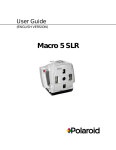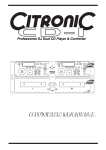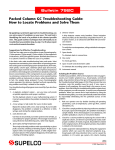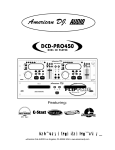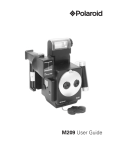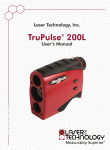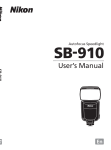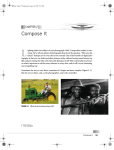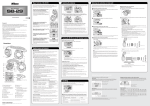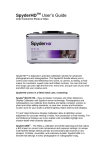Download Polaroid Captiva AF Instant Camera
Transcript
2 This product is listed by Underwriters’ Laboratories, Inc. As a condition of listing, UL requires that basic safety information be provided. IMPORTANT SAFETY INSTRUCTIONS AS WITH ANY BATTERY-OPERATED EQUIPMENT, OBSERVE THESE BASIC SAFETY PRECAUTIONS: 1 FOLLOW ALL THESE INSTRUCTIONS. 2 CLOSELY SUPERVISE THE CAMERA WHEN IT IS BEING USED BY OR NEAR CHILDREN. 3 DO NOT USE THE CAMERA IF IT HAS BEEN DROPPED OR DAMAGED, UNTIL IT HAS BEEN EXAMINED BY AN AUTHORIZED POLAROID SERVICE CENTER. 4 TO AVOID THE RISK OF AN ELECTRIC SHOCK, DO NOT DISASSEMBLE THE CAMERA. SERVICE OR REPAIR WORK MUST BE DONE ONLY BY AN AUTHORIZED POLAROID SERVICE CENTER. INCORRECT REASSEMBLY CAN CAUSE AN ELECTRIC SHOCK WHEN THE CAMERA IS USED AGAIN. DO NOT IMMERSE THE CAMERA IN WATER OR OTHER FLUIDS. PLEASE KEEP THESE INSTRUCTIONS. TABLE OF CONTENTS 3 5 5 6 6 7 7 8 8 9 9 10 10 10 Camera features Loading the film Opening the camera Positioning your subject Taking the picture Removing the pictures Brightness override Self timer Close-up lens accessory Camera signals Trouble-free picture-taking Full five-year warranty Americas Business Center Information for the user 3 Camera features Film • Use only Polaroid 500 instant color film • Ten pictures per pack • A mercury-free battery in the film pack powers the camera and flash 4 Camera features The Polaroid Captiva instant camera is a fully automatic, autofocus, single-lens reflex camera. It features built-in “fill” flash, through-the-lens viewing, a front-element lens, a self-timer, and automatic picture storage with a viewing window. Customer Assistance If you ever need help with your Polaroid Captiva camera or film, please follow the instructions on page 11. New cameras Your camera has been packed with a copy of a Captiva photograph in the storage compartment to demonstrate how the compartment works. Remove and discard before taking pictures (see page 7 for picture removal). 5 Loading the film • Use only Polaroid 500 instant color film • Check the “Use before” date printed on the box; do not use outdated film • For ease of loading, load the film with the camera closed • Check the rollers (see page 9) Slide the film door latch; the door will pop open. Lift the door up until it stops. Hold the film pack by its edges with the arrows facing you. Slide the pack into the camera in the direction of the arrows, as shown. Close the film door; the film cover will advance automatically into the storage compartment and the counter will advance to 10. (The picture counter counts down, indicating the number of pictures left.) To remove an empty film pack Open the film door and slide the pack out by its edges. Opening the camera Holding the camera by the grip in your left hand, press the button on the top of the flash unit with your right thumb and push the flash until the camera clicks into its open position. If the camera is loaded with film, the red light on the back of the flash unit will come on for a few seconds, then the green light will come on to indicate the camera is ready to use. To save energy, the flash is designed to shut off automatically after 30 seconds, but will turn on as soon as your finger touches the shutter button. To close the camera Press the button on top of the flash and firmly pull the flash unit down to its original position. Then press the camera together until it snaps closed. After picture-taking, be sure to wait until the picture has advanced into the storage compartment before closing the camera. 6 Positioning your subject Hold the camera grips as shown, resting your right index finger on the shutter button. Look through the viewfinder to compose your picture; what you see is exactly what your picture will include. Note: If the viewfinder appears black, the camera is not fully opened. Push the flash forward until the camera clicks open. For vertical pictures such as portraits and individual subjects, turn the camera sideways for best results. To minimize shadows, be sure the flash is on top, as shown. The camera orientation symbol on the back of the flash unit will remind you how to hold the camera. Indoors, your subject should be between 2 to 10 ft. (.6 to 3m) away and near a light colorful background for best results. Outdoors, your subject should be at least 2 ft. (.6m) away. Keep the sun behind you or to your side. The flash will recharge for the next picture within seconds. The picture will advance automatically into the picture storage compartment, on top of the previous picture. The pictures are dry and will not stick together. The image will start to appear in less than a minute. The picture can be removed immediately or stored in the compartment, which can hold all the prints from one pack of film, plus the film cover. Taking the picture When the green light is on, the flash is fully charged. If it is not on, touch the shutter button lightly to charge the flash. The flash always fires, outdoors and indoors, in all lighting situations. Press the shutter button to take the picture. The viewfinder will go black; hold the camera steady until you can see the scene through the viewfinder again. 7 Removing the pictures To remove one or more pictures, open the removal door as shown. Pictures can be removed and reinserted as desired. Caution: Store only Polaroid 500 instant color film pictures in the storage compartment. Before loading a new pack of film, remove all the pictures and the film cover. Then close the picture removal door. Full storage compartment Picture counter When the storage compartment is full, the camera will not allow you to take another picture until you remove the pictures. As a reminder, the red light will flash and the camera will sound a two-tone beep. The picture counter counts down, indicating the number of pictures left, and displays a red zero as soon as you take your last picture. Empty film pack The camera will not function when the film pack is empty. The red light will flash and the camera will beep when you take the last picture, and when you press the shutter button or open the camera. To remove an empty film pack, open the film door and slide the pack out by its edges. Brightness override For most situations, leave the control at the normal (center) setting. Use this control to reshoot a picture to make it lighter or darker. To take a lighter picture, slide the control to the right, towards the white-dot arrow. To take a darker picture, slide the control to the left, towards the black-dot arrow. Be sure to reset the control to the normal setting before taking your next picture. (When you close the camera, the control will automatically be reset to normal.) The control cannot be set when the camera is closed. 8 Self-timer Place the camera on a tripod or other steady support. Frame your picture. Indoors, plan to stand 2 to 10 ft. (.6 to 3m) from the camera. When you are ready, slide the control to the right once, toward the clock symbol (it will spring back). You now have approximately 12 seconds to get into your picture. The red light on the front of the camera will flash at an increasing rate, becoming steady just before the flash fires. The camera will also beep at an increasing rate, becoming steady just before the flash fires. To cancel the self-timer exposure, simply slide the switch to the right again. Closing the camera will also cancel it. Close-up lens accessory (optional) With the optional close-up lens you can make images of 1/3 actual size from 10 to 14 inches. To use the accessory, open the camera and hold it firmly by the flash tower. Attach the close-up lens accessory, placing its lens over the camera lens, and its diffuser over the flash. Press the attachment until it snaps securely into place. To measure the appropriate distance from your subject, stretch the neckstrap taut and place the metal loop at the subject. Then drop the strap, maintain the distance, and shoot. 9 Camera signals Red light The camera will not take a picture when the red light on the electronic flash unit is on. When the light is steady: • The flash is charging • The battery in the pack is low (film may be outdated) When the light flashes eight times: • The film pack is empty • The storage compartment is full • A picture did not advance all the way into the storage compartment (stopped picture – see below) Audible signals the film pack first. Insert the tip of a ballpoint pen into the small square in the red bar as shown. Pivot the red bar out of the way for access to both rollers. Clean the rollers with a lint-free cloth or a cotton swab dampened with water while manually turning the roller gear with your finger. Close the bar. Reload the film; the top picture will be lost, and will advance into the storage compartment. The picture counter will reset to 10 and will miscount the rest of the pack. Clearing a stopped picture Black viewfinder If a picture or film cover should ever stop before reaching the storage compartment, the camera may not operate and the red light may flash. The camera may also sound a two-tone beep. To remove the picture, unlatch the film loading door and pull it open firmly but carefully. This may require more force than usual. Then pull the stopped picture out of the camera. Remove the film pack and clean the rollers. Reload the film pack. The next print will advance into the storage compartment. Note: The picture counter will reset to 10, and will miscount the rest of the pack. If you can’t see through the viewfinder, the camera is not fully open. Push the flash forward until it clicks into position. • Empty film pack: Four beeps • Full storage compartment: Two-tone beep, four times • Stopped picture: Two-tone beep, four times (see below) • Self timer: Accelerating beep, becoming steady just before exposure Trouble-free picture taking Cleaning the rollers For best results, check your rollers before loading each pack of film. A speck of dirt or developer on the stainless steel rollers will result in repeated spots across the picture (see page 10). If you need to clean the rollers when the camera is loaded with film, remove The film • For best results, take pictures when the temperature is above 55° F (13°C). • Below 55° F (13°C), pictures can have a blue tint. Keep your camera and film as warm as possible; place developing pictures in a warm pocket. • In hot temperatures, keep camera and film as cool as possible. Avoid storing loaded camera in direct sun, or in the glove or luggage compartment of a car. • Store film below 75° F (24°C); do not freeze. Outdated film will produce pictures with a blue tint; check the “Use before” date on the film box. The lens Avoid touching the lens. To remove dust or fingerprints, breathe on the lens and wipe it gently with a lens tissue or a clean, soft facial tissue. Do not use siliconetreated eyeglass tissues. 10 Full five-year warranty If this camera proves to be defective during the warranty period, we will, without charge, either repair it or, at our option, replace it with a fully reconditioned or new unit. The warranty period is five years from the original date of purchase. To verify the warranty period, you should keep the sales slip or other proof of the purchase date. The repair or replacement of the unit is guaranteed for the remaining warranty period of the original unit. The warranty does not cover damage caused by accident, misuse or tampering with the unit, and a charge will be made for such repairs. For warranty service or information, call our toll-free number listed below. If your camera is not working, our representatives will verify the problem and can ship a replacement unit to you quickly (within approximately two or three Polaroid business days in the U.S.A.). U.S.A. only: This warranty gives you specific legal rights, and you may also have other rights, which vary from state to state. This warranty excludes all consequential damages. Some states do not allow the exclusion of consequential damages, so the foregoing exclusion may not apply to you. Canada only: The above warranty and provisions do not affect your statutory rights. Americas Business Center Information for the user If you have any questions about your camera or pictures, you believe your camera needs repair, or you need additional information, call us toll-free: This device complies with Part 15 of the FCC rules. Operation is subject to the following two conditions: • This device may not cause harmful interference. • This device must accept any interference received, including interference that may cause undesired operation. U.S.A. and Canada 1-800-343-5000 from anywhere in the U.S.A. Our representatives can be reached every weekday from 8 am to 8 pm, Eastern time. In Canada, call toll-free: 1800-268-6970. In Toronto, call 675-3680. Or, if you prefer, write to us. The address is: Americas Business Center, 201 Burlington Rd., Bedford, Massachusetts 01730. Please include a sample picture of the problem you are having with your camera. Polaroid 500 instant color film, by that name, is sold in the U.S.A., Canada, and Latin America. Before traveling to countries outside the U.S.A. and Canada, call us toll-free to learn where film for your camera is being sold. Note: This equipment has been tested and found to comply with the limits for a Class B digital device, in accordance with Part 15 of the FCC rules. These limits are designed to provide reasonable protection against harmful interference to radio communications in a residential installation. This equipment generates, uses and can radiate radio frequency energy. If not installed and used in accordance with the instructions, it may cause harmful interference to radio communications. If this equipment does cause harmful interference to radio or television reception (determined by whether interference exists when the equipment is in use), you should correct the interference by one or both of these methods: • reorient or relocate the receiving antenna of the radio or television set • increase the separation between the equipment and the receiver For more information: From within the U.S.A., please call us toll-free at 1-800-343-5000, Monday through Friday, 8 am to 8 pm (Eastern time). In Canada, call toll-free: 1-800-268-6970; in Toronto, call 675-3680. This digital apparatus does not exceed the Class B limits for radio noise emissions from digital apparatus set out in the Radio Interference Regulations of the Canadian Department of Communications. Polaroid® registered trademark of/ marque déposée de Polaroid Corporation, MA., U.S.A. PN5528A 5/93 Printed in U.S.A.










